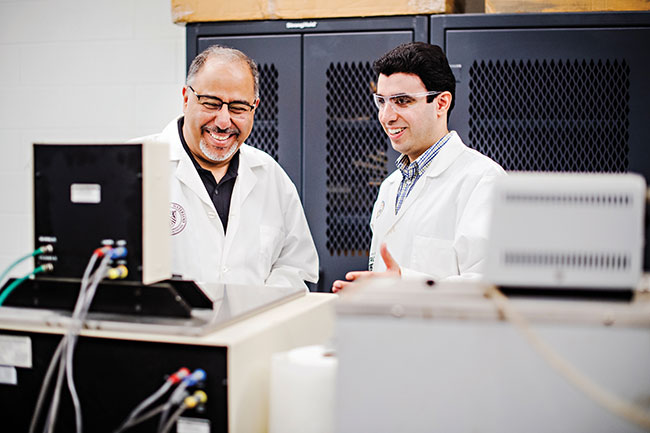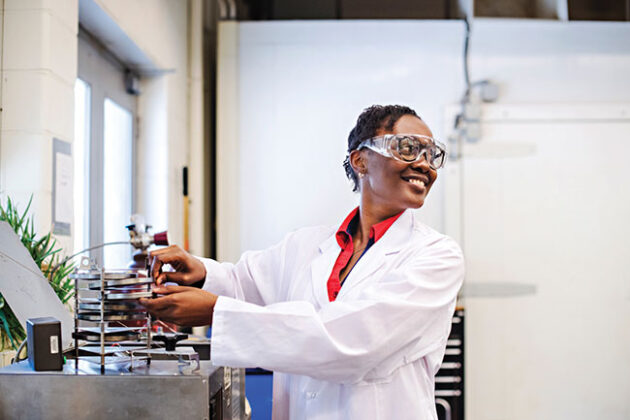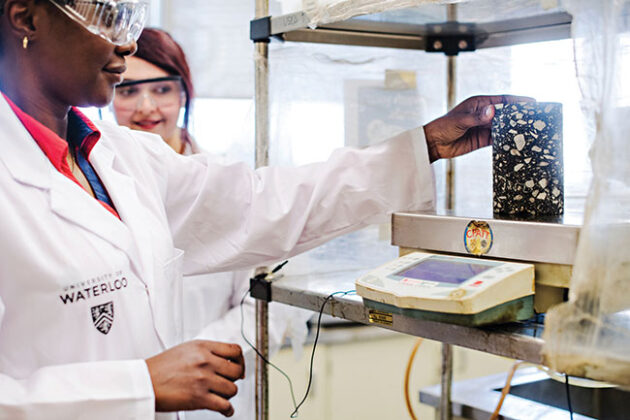
Features
Technology
Inside Waterloo’s thoroughfare think tank
The University of Waterloo’s Centre for Pavement and Transportation Technology is breaking boundaries
October 31, 2023 By Jack Burton
 Director of UW’s CPATT Prof. Hassan Baaj, alongside Jr. Norman W. McLeod chair Prof. Pejoohan Tavassotti, are paving the way for the future of Canada’s roads. Photo provided by CPATT.
Director of UW’s CPATT Prof. Hassan Baaj, alongside Jr. Norman W. McLeod chair Prof. Pejoohan Tavassotti, are paving the way for the future of Canada’s roads. Photo provided by CPATT. Concrete, asphalt, aggregates — you may know the ingredients for a good road, but what makes for a good road recipe? At the University of Waterloo’s (UW) Centre for Pavement and Transportation Technology (CPATT), the cookbook for the future of Canada’s roads is being written, and the not-so-secret ingredient is science.
CPATT is many things, from a training ground for the next generation of road researchers to a crucial touchpoint of Canadian infrastructure, but watching recent CPATT graduate Dr. Rob Aurilio pour a small pouch of aggregate material into a contraption resembling a futuristic hot dog cart, one recalls a master chef hard at work in their test kitchen.
In moments, a conveyor inside the machine begins moving, and these sprinkles of pebble transform into fist-sized outlines that flash rapidly on a screen outside the device. It’s technology for analyzing the average shape of road aggregate batches, Aurilio explains, and his enthusiastic grin shows that cooking up better roads isn’t just CPATT’s mission, but their pride.
Driving roads forward
For the past four decades, CPATT has existed as a touchpoint of innovation between the public sector, the private sector and several of UW’s engineering research departments, driving the evolution of roads on the national stage and beyond.
Initially concerned with standard research into pavement health and lifecycle management, CPATT has since grown into an institution tackling hot-button issues like sustainable pavements. Each of its pursuits aim to evolve how Canada looks at its roads.
“What began as finding solutions to the service life and construction of pavements turned into research on the use of recycled and alternative materials and, little by little, informed all of our findings. Our research has evolved toward more advanced solutions,” said Professor Hassan Baaj, UW’s Norman W. McLeod Chair in Sustainable Pavement Engineering, and the current director of CPATT.
These advanced solutions aim to push the average driver’s idea of what the road beneath their wheels is capable of, including their recent pursuit of developing pavements integrated with artificial intelligence that provides maintenance data and, in turn, predicts the future of the road’s overall lifecycle.
“We brought in artificial intelligence to create our own proactive pavement management system. Having sensors implemented in the pavement that will not only detect if cracks are happening or what stresses are creating them, but coming up with algorithms that will tell us, based on the data, how this pavement will hold up over time,” said Baaj.
The department is also exploring another innovative idea: self-healing pavements. These roads would be capable of repairing wear and tear on their own behalf, removing the need for additional labour or active, in-person maintenance.
“We, along with many other pavement research facilities, do a lot of work on finding solutions for cracking, as it’s one of the major issues faced by [Canada’s] pavement,” said Baaj. “One question we’re trying to find an answer for is, what if pavement could heal these cracks itself, instead of crews having to return to remove and replace the asphalt?”

Dr. Abimbola Grace Oyeyi at UW’s Centre for Pavement and Transportation Technology. Photo provided by CPATT.
An interdisciplinary intersection
For more than 20 years Baaj has been researching — and rethinking — what roads can be. After receiving his doctorate in 2002 in France and returning to Canada to complete a one-year postdoctoral program at the National Research Council, he worked with some of the major international players in the construction materials and paving industries, before ultimately joining the University of Waterloo.
Baaj’s work with CPATT began in 2014. In this position, he helps oversee CPATT’s central lab facilities at the university, their main field test lab, and an additional infield test site at Waterloo region’s waste management facility.
The array of resources that Baaj and his team have at their fingertips supports a number of comprehensive processes, including structural design, advanced materials characterization, geotechnical engineering, field evaluations, equipment and data processing and risk testing; all of which help place CPATT on the cutting edge of envisioning the future of our roads.
CPATT’s Professor Pejoohan Tavassoti, an assistant professor of civil and environmental engineering who holds the Jr. Norman W. McLeod Chair in Sustainable Pavement Engineering, also recognizes the interdisciplinary toolbox that UW provides and the results it makes possible.
“The beauty of this thing is that you have access to a wide range of technologies and infrastructures here at the university that we’re always trying to leverage in developing solutions that will meet the needs of paving today and in the future,” he said. “For example, if we were developing a material for sustainability, we could collaborate with other professors to look at the environmental impact and assess it from different scales and perspectives.”
The range of resources at CPATT’s fingertips is one of the qualities that brought Tavassoti to Waterloo as a research associate five years ago from the United States, where he worked alongside of some of the teams leading Superpave research and alongside the US Department of Transportation on recycled asphalt projects.
In addition to his role with CPATT, Tavassoti is a major player in spotlighting sustainability in transportation technology and materials research, currently serving as vice-chair of the Ontario Asphalt Expert Task Group (OAETG) and leading one of two task groups in bituminous binders fingerprinting technical committee for RILEM.
These interests stand in alignment with the goals and concerns of CPATT as a whole, with future-friendly solutions that look to manage roadbuilding’s environmental impacts playing a significant role in the faculty’s current research interests and overall philosophy.
“We have [sustainability] at the core of all of our research projects,” Baaj shared. “It’s a very important aspect of our research – it’s everywhere, honestly.”

The access and mentorship CPATT and the University provides has set up students like Dr. Abimbola Grace Oyeyi for success, with Oyeyi to begin an assistant professorship at the University of Windsor. Photo provided by CPATT.
Sustainability at every stop
For CPATT, sustainability is a multifaceted idea, one that encapsulates not just the environmental impacts usually associated with the concept, but also solutions that can sustain traffic and weather demands or those which mindfully manage construction material resources.
“We try to keep an eye on all of those well-known pillars of sustainable development and quality, so that whatever solution we come up with is both economically viable and, at the same time, environmentally friendly,” said Tavassoti.
Rising infrastructure demands across Canada have made sustainable, long-lasting roads a valued solution, whether that be in their reduced future maintenance costs or a minimized burden on material resources and supply chains.
“There’s a high demand for building more infrastructure, which means more demand for natural resources and construction materials,” Tavassoti said. “But it’s also about optimizing the durability of this infrastructure to avoid any premature failures that you are not planning for, while at the same time keeping an eye on the impact on the environment, because the scale of these projects only goes up.”
One way that CPATT hopes to redefine the sector’s approach to sustainability is the team’s inquiry into non-destructive testing methods. While standard testing methods for road diagnostics may involve practices that demand repairs, like removing sections for sampling purposes, non-destructive testing methods provide necessary data at no impact to the health of the road.
“Traditionally, one would tend to take cores and drill holes in the pavement for testing, but non-destructive testing, to think about it in terms of the medical world, is like performing a sonography or ultrasound [on the pavement],” said Tavassoti, who currently specializes in this area. “By using a lot of wave-based technologies to map information such as the integrity of the pavement structure, we can get results without being intrusive or invasive.”
Just as integral are the sites and facilities that allow CPATT to, quite literally, put their questions to the test. For Baaj, what defines a comprehensive, state-of-the-art research facility for paving and road research is more than just the tools; it’s also about technique and, even more importantly, the team.
“In addition to the basic equipment, you need to be able to prepare your mixes, to know your asphalt binders and your cements, and to be able to prepare samples and slabs that are representative to real life – but that’s just the starting point,” said Baaj. “It’s so much more than just collecting the data – it’s about having the knowledge and personnel able to understand and translate that data into useful models.”
Even with numerous high-caliber academic faculties at their fingertips, multiple on-campus labs, research partnerships with industry associations, and off-site testing facilities, for CPATT, its most important resource – and the project that Baaj has the most passion for – are the students.
“I think our biggest and most important product is what is called highly qualified personnel. The students we train and prepare to become researchers, engineers and entrepreneurs,” said Baaj. “Half of our focus at CPATT might be conducting research and creating new solutions, but the other half, which really drives the first, is preparing students to become an important part of this research community.”
Baaj’s motivation is not unnoticed by CPATT’s students, who recognize and relish the privileges that emerge from the lab’s investment in their own research journeys, from cutting-edge contraptions to collaborations with the top minds in their field.
Dr. Abimbola Grace Oyeyi arrived at CPATT in 2016 from Nigeria and is set to start as an assistant professor at the University of Windsor this fall after completing her Ph.D. in December of 2022. It’s the opportunities for mentorship and collaboration fostered by Baaj and the university at large that brought her across the world to continue her research pursuits.
“We can really leverage the fact that we’re able to collaborate with other departments – for instance, because we’re doing a lot of sustainability research and assessments, we’re able to collaborate with the environment departments, trying to see how we can integrate their research with pavement research,” Oyeyi said. “There’s room for that collaboration at Waterloo, and that’s something I think is really great.”
Print this page